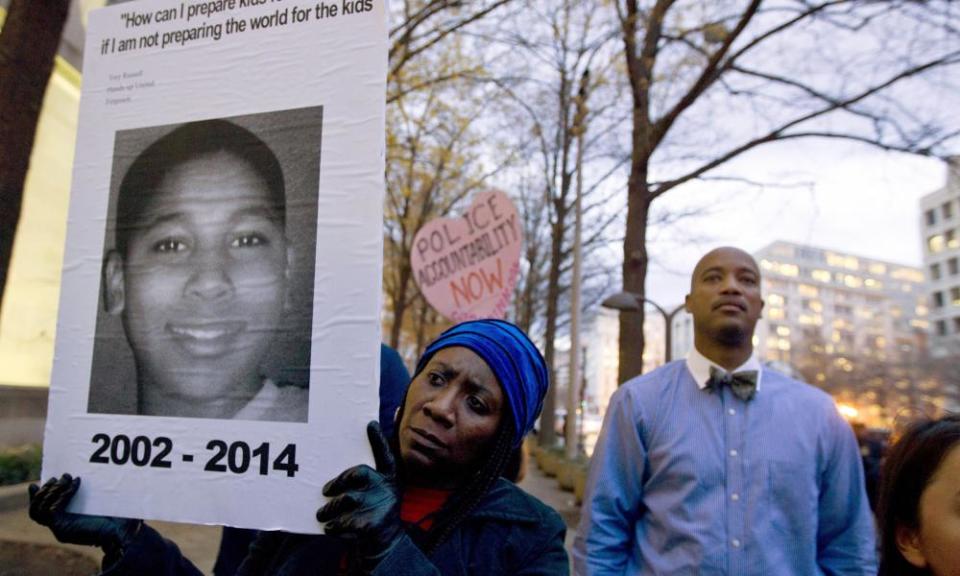'My duty as a black man': the artist preserving gazebo where police killed Tamir Rice
Three years ago, the Chicago visual artist Theaster Gates acquired the gazebo 12-year-old Tamir Rice was shot and killed under by a police officer. The object, which Gates describes as “sacred”, has become the centerpiece of a garden, flowers blooming around the site of pain and tragedy. Gates is quick to say he does not want the gazebo. That it belongs in Cleveland, Ohio, where Tamir lived and died. But the city was set on removing the object – now symbolic of the scores of young, unarmed black men killed by our police force – from Cleveland’s Cudell Recreation Center.
“Caring for this gazebo felt like my duty as a black man,” Gates said. “But it should not be in Chicago. It’s in Chicago, in some ways, because of the anxiety that mounts when bad things happen [somewhere].”
Gates stepped in after Samaria Rice, Tamir’s mother, reached out to him personally. Over the years, Samaria and Theaster have developed a special bond. Especially as Samaria has worked with numerous black artists to honor her son’s legacy, with the Tamir Rice Afrocentric Cultural Center currently in development.
“There were no propagandists on the line with us or a film crew,” Gates says of him and Samaria transporting the gazebo from Cleveland to his studio space in Chicago. “For the two years the gazebo sat in my studio, there was no major art reporters coming to my studio. Because I didn’t ask anyone. We were just trying to be diligent with the hurt that Samaria experienced when she lost her son.”

Collecting neglected black cultural objects is a chief focus of Gates’s artistic practice. He has curated vintage issues of black-centric magazines Ebony and Jet and archived racist “negrobilia”, all in the hopes of preserving and displaying the complicated history of race in America.
Gates said: “The objects I’ve accumulated, I usually have them because someone called me and said, ‘Hey, I need some help.’ In some cases, I’m just a temporary steward and [providing] safekeeping until they find a better home.”
Gates spoke to the Guardian from Cleveland, where on Wednesday he appeared at an event centered around arts and activism and linked to the fifth anniversary of Tamir’s death, with other artists including EJ Hill, Michael Rakowitz and Cleveland-based Amanda D King, who runs Shooting Without Bullets, a youth arts collective.
Tamir’s death has left a permanent mark on the city of Cleveland. After a three-year investigation and numerous protests, the officer who fatally shot Tamir was fired by the Cleveland police department – but never faced charges. Tamir’s family received $6m from the city in a 2016 settlement. In the wake of Tamir’s death, artists across the nation – from Ava DuVernay to Michael Rakowitz – have explored his politicized death in their works.
When I ask Gates what, if anything, has changed for black people since Tamir’s death, the artist is surprisingly positive.
He highlights two exciting occasions: “The lynching memorial by Bryan Stevenson in Alabama – which is a tangible piece of black history in a place of extremely conservative power. And in Chicago, we have our first black, female, queer leader [Lori Lightfoot], who is asking very hard questions of the police. There are people on the ground who believe everyone has the right to citizenship and humanity. And we’re working and fighting to make that real.”
The artist is hoping to begin talks with Cleveland city officials about returning the gazebo “to where it belongs”. From our conversation, Gates seems to envision a city-sanctioned and -funded memorial. “I want to believe that the city is open to it,” he said. “I believe Samaria has the right to ask the city to receive this sacred space.”
Tamir Rice’s murder strikes a deep chord with Gates, myself, and every other black man in America because we intimately understand how his death could have been ours. Gates has his own collection of close-calls with police officers. He was 14 and playing a game of football with his friends when a police officer, who assumed a black kid running fast must be up to no good, stopped Gates and raised a gun to his head.
“I knew that if I said the wrong thing that I could die,” Gates recollected. “What do I have in common with Tamir? I’m black and I’m a threat.”
Samaria Rice and her supporters are seeking funding for the creation of the Tamir Rice Afrocentric Cultural Centre, which will be to “provide arts, cultural, educational, and civic programs for youth ages 10-19 that celebrate the history and culture of people of African descent in Cleveland”.
City champions project launching next week
On Monday 25 November the Guardian-US and Guardian Cities is launching a new series called City Champions, which will report on inspiring people, groups and grassroots initiatives that are transforming lives for the better in cities in the US.
The first installment in the series will focus on Cleveland, Ohio, and will highlight community-based projects that are offering potential solutions to systemic issues including inequality, structural racism, infant mortality and lead poisoning.
For the project, the Guardian has also commissioned art works that are now on display on six billboards in the city, which seek to visualise some of the complex social justice issues affecting lives and communities.
This public art project is in partnership with For Freedoms, a national collective of artists who worked with Amanda King and other local artists – Robert Banks, Matt Chasney, Amber N Ford and Noelle Richard – as well as young people from King’s art collective, Shooting Without Bullets.

